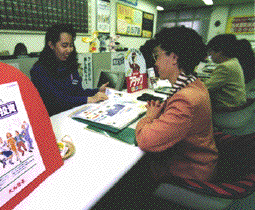
Companies debuting on the new market will depend on individual investors.
SECOND OTC MARKET TAKES OFF:
New Bourse Hopes to Foster Start-ups
FEBRUARY 10, 1997

Companies debuting on the new
market will depend on individual investors.
Market to Provide Venue for Young, Venture-Backed Firms
The first significant activity on Japan's second over-the-counter
(OTC) stock market occurred at the end of last year. Catering to promising
start-ups backed by venture capital, the new market got off to a start with
public offerings by two companies. More than ten others are set to follow
suit during the first half of this year.
What most distinguishes this second OTC market, which was specially created to support venture-backed start-ups suffering funding difficulties, is that it is open to loss-making companies, as long as they are deemed to be innovatively engaged in a growth business, and have research and development outlays totaling at least 3% of sales.
The first public offering on the new OTC market was made by a software developer specializing in business-use products such as sales and accounts-management programs that can also be used on the Internet. The second was by a developer and maker of integrated circuits for crystal oscillators. Both firms posted losses in their previous fiscal year. The software firm plans to use the roughly 200 million yen (1.67 million dollars at the rate of 120 yen to the dollar) it raised to cover capital investment costs and borrowings.
An official stressed his gratitude for the chance to raise so much, even though the company was "still in the red five years after its establishment." But he also pointed out that the shares had been bought "solely on the strength of potential, not of performance to date." He likened the pressure on the company to that felt by "an Olympic competitor expected to win a medal."
A Japanese NASDAQ
Fostering venture-backed start-ups can be considered the economic
equivalent of cultivating delicate plants. As such, there is still a wide
difference between the U.S. and Japan in terms of the availability and
depth of nourishing soil. Start-ups' biggest problem is obtaining funds. In
America, there is a stratum of several hundred thousand individual
investors keen to put their money into high-risk, high-return ventures.
These so-called "angels" are thought to be the source of as much as 25
billion dollars each year in loans and investment.
There are also some 600 companies that provide venture capital, and invest in a wide range of start-ups, from those newly formed to those already on a growth track. It is estimated that the total of outstanding investments by such companies was 30 billion dollars or so at the end of 1994.
The National Association of Securities Dealers Automated Quotations (NASDAQ) system, the model for Japan's second OTC market, had 5,955 stocks on its roster as of the end of 1995, approximately twice as many as on the New York Stock Exchange. Its turnover was about 20% greater than that of the NYSE. NASDAQ is a lively market, with around 500 companies listing and 200 delisting every year. Strings of high-tech success stories have emerged from among its listed venture-backed start-ups.
In Japan, by contrast, financial institutions offering indirect financing have been reluctant to back start-ups. There are only about 100 companies providing venture capital, and their outstanding balance of investment was around 850 billion yen (8.5 billion dollars at the rate of 100 yen to dollar) at the end of 1994, less than a third of the comparable level in the U.S.
And the concept of "angels" has not yet taken root. In fact, the only Japanese behaving like "angels" seem to be a very small number of people who are themselves successful entrepreneurs. Furthermore, although the listing requirements of the first OTC market, started in 1961 to nurture second-tier companies, are less strict than those of the stock exchanges, it still keeps out loss-making companies and maintains other restrictions.
For that reason, the average annual number of new registrations is lower than 30. As of the end of last year, there were only 800 stocks on the roster, one-seventh the comparable number in the U.S. With an average daily volume of around 10 million shares, it sees only one-twentieth the trading activity of the Tokyo Stock Exchange.
Thus, the second OTC market was established. Although it is still in its infancy, recent state and private-sector initiatives for entrepreneurs have encouraged the emergence of a corps of young managerial talent. Now there is a real possibility that the second OTC market will give a powerful lift to a wave of new companies.
Ordinarily, a public offering is preceded by two or three years of preparatory work, including drawing up of documents, by the company concerned and a securities house. But by accumulating data on candidates for listing, a single top-rank brokerage can prepare the public offerings of 50 or 100 firms on the second OTC market.
For investors, playing the new OTC market involves high risks as well as high returns. But brokerages and start-ups hope that it can do in Japan what NASDAQ did in the U.S., and that a stream of winners will emerge from among its listed firms.